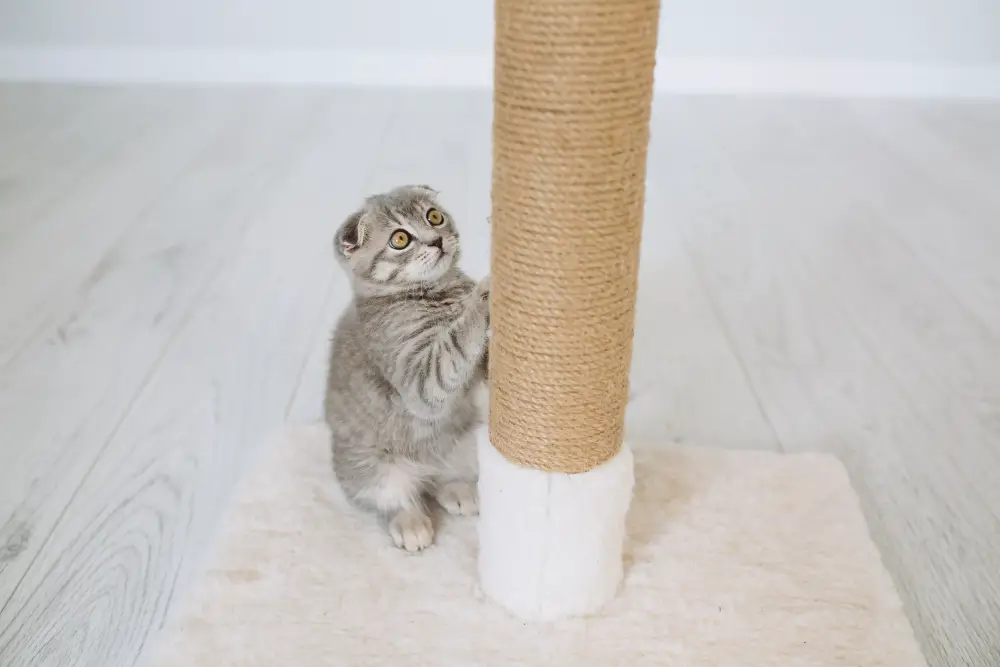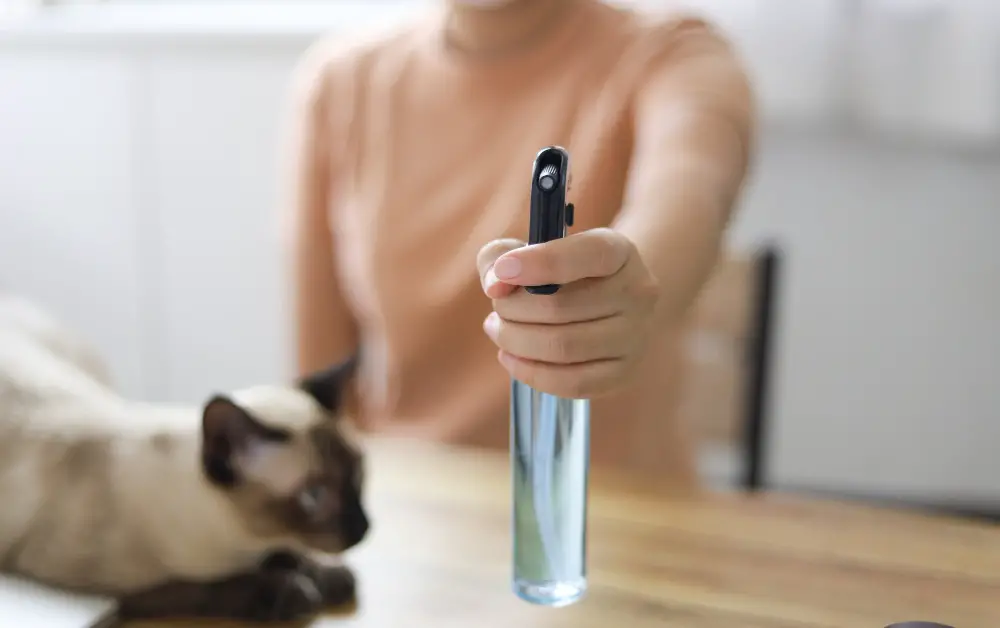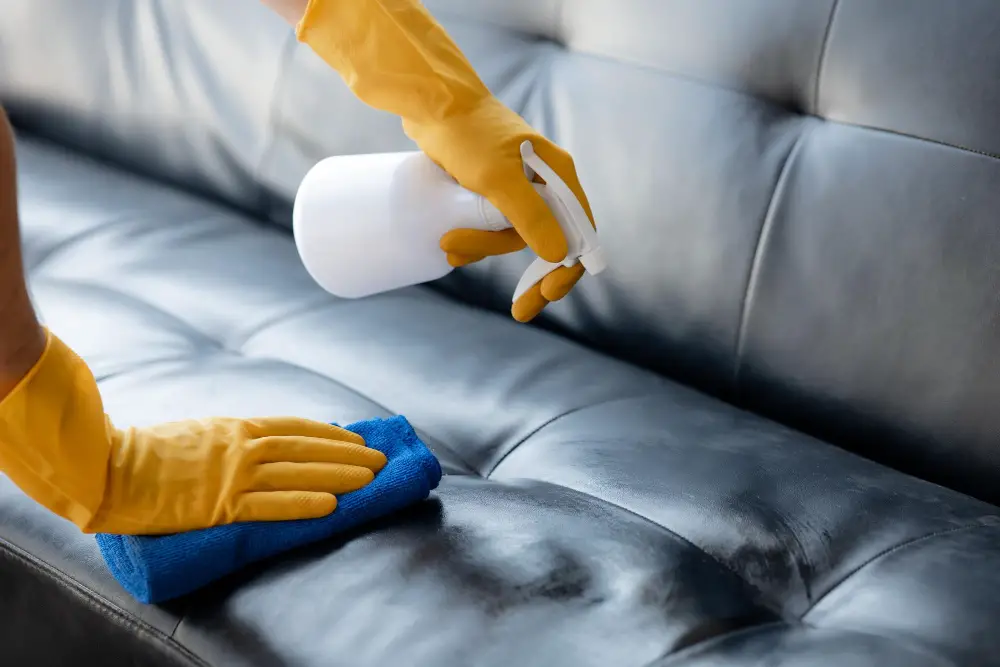Last updated on
Discover effective methods to safeguard your cherished leather couch from feline-induced damage, ensuring its longevity and pristine condition.
If you’re a cat owner, you know how much your furry friend loves to scratch. And unfortunately, sometimes that means scratching on your leather couch.
Not only can this be frustrating for you as a homeowner, but it can also lead to costly repairs or even having to replace the entire sofa. But fear not! There are ways to protect your leather couch from your cat’s claws without sacrificing style or comfort.
In this article, we’ll go over some tips and tricks on how to keep your feline friend from ruining your furniture while still enjoying their company in the comfort of your home. So grab a cup of coffee and let’s get started!
Table of Contents
Understanding Cat Scratching Behavior

Cats are natural scratchers, and it’s essential to understand why they do it before you can protect your leather couch from their claws. Scratching is a way for cats to mark their territory, stretch their muscles, and sharpen their claws.
It’s also a form of communication as they leave visual marks and scents behind that other cats can pick up on.
It’s important to note that scratching is not just about keeping your cat entertained or happy; it’s an instinctual behavior necessary for the physical health of your feline friend. Therefore, trying to stop them from scratching altogether isn’t the solution.
Instead of stopping them completely from scratching on furniture like leather couches (which may be impossible), we need to redirect this behavior towards more appropriate options while still ensuring our furniture remains intact.
Choosing the Right Leather Couch

Not all leathers are created equal, and some are more resistant to scratches than others. Opt for a full-grain or top-grain leather as they tend to be thicker and more durable than other types of leather.
Another important factor in choosing the right couch is color. Lighter colored leathers may show scratches more easily than darker colors, so keep that in mind when making your selection.
Consider the texture of the leather – smooth finishes can be easier for cats to scratch while textured finishes may provide them with less traction.
Cat-Proofing Your Couch

This involves creating a barrier between your feline friend and the furniture, making it less appealing for them to scratch on. One way to do this is by using double-sided tape or aluminum foil on areas where your cat likes to scratch.
Cats dislike sticky surfaces and shiny objects, so they will likely avoid these areas altogether.
Another option is investing in a scratching post or pad that can be placed near the couch as an alternative scratching surface for cats. You can also try placing toys or treats around the area as distractions.
If you have multiple cats, consider providing each with their own designated space and furniture items such as beds, towers, perches etc., which may help reduce territorial disputes over shared spaces like sofas.
Regularly Maintaining Leather

Regular maintenance of your leather couch can help prevent damage caused by cat scratches or other factors.
To keep your leather couch in good condition, you should clean it regularly with a soft cloth or vacuum cleaner. Avoid using harsh chemicals that can damage the surface of the leather.
Instead, use mild soap and water to remove any dirt or stains.
It’s also important to moisturize your leather furniture every few months with a specialized conditioner designed for this purpose. This will help prevent cracking and drying out of the material over time.
Couch Placement Matters

Cats are creatures of habit and will often return to their favorite spots for scratching or lounging. Therefore, it’s essential to place your leather couch in an area that discourages these behaviors.
Avoid placing your sofa near windows or doors where outdoor stimuli can trigger a cat’s urge to scratch. Instead, consider positioning it against a wall with minimal foot traffic and away from any potential distractions.
You may want to create designated areas for your cat’s scratching needs by placing scratch posts nearby or providing alternative surfaces such as cardboard boxes or mats specifically designed for feline use.
Trimming Cat’s Claws

This will not only prevent them from causing damage but also keep your cat healthy and comfortable.
If you’re new to trimming a cat’s claws, it may seem daunting at first. However, with practice and patience, it can become a routine part of your pet care regimen.
To start off, make sure you have proper nail clippers designed for cats. You can find these at any pet store or online retailer.
It’s important to avoid using human nail clippers as they are not suitable for pets’ nails.
Next, gently hold your cat in place while ensuring that they are calm and relaxed before starting the process. If necessary use treats or toys as distractions during this time.
Once you’re ready to begin clipping their nails one by one making sure not cut too close to the quick (the pink area inside each claw). Cutting into this area could cause pain and bleeding which would be uncomfortable for both you and your feline friend!
Trim Your Cat’s Nails Regularly

Cats’ claws can grow quickly, and if left untrimmed, they can become sharp and cause damage to furniture. Trimming their nails not only helps prevent damage but also keeps them healthy.
To trim your cat’s nails, you’ll need a pair of specialized pet nail clippers that are designed for cats. It’s important to be gentle when trimming their claws as it can be uncomfortable for them if done incorrectly.
Start by holding your cat securely in a comfortable position on your lap or on a table with non-slip padding underneath. Gently press down on the paw pad to expose the claw and locate where the pink quick ends and cut just below it at an angle.
If you’re unsure about how much to trim or feel nervous about doing it yourself, consider taking them to a professional groomer or veterinarian who will do this safely without causing any harm.
Apply Nail Caps to Your Cat’s Claws

Nail caps are small plastic covers that fit over the cat’s claws and prevent them from causing damage when they scratch. They come in a variety of colors and sizes, so you can find ones that match your cat’s personality.
To apply nail caps, start by trimming your cat’s nails and cleaning their paws with soap and water. Then gently press on the cap until it fits snugly over the claw.
You may need to hold it in place for a few seconds until it adheres properly.
It is important to note that while nail caps are effective at preventing damage from scratching, they do require regular maintenance as they will eventually fall off as new claws grow in. It is also crucial not to leave them on for too long as this could cause discomfort or even infection if left unattended.
Providing Scratch Alternatives

You can provide them with alternatives to scratching your leather couch. One of the best ways is by providing a scratching post or pad near the couch.
This will give your cat a designated area where they are allowed to scratch without damaging your furniture.
When choosing a scratching post or pad, make sure it’s tall enough for your cat to stretch out fully and sturdy enough so that it won’t tip over when in use. You may also want to consider different textures such as sisal rope or cardboard since cats have preferences on what material feels good under their paws.
Another option is using double-sided tape on areas of the couch where you don’t want them scratched; this will deter them from using those spots as their personal nail file.
Provide Alternative Scratching Options

Providing alternative scratching options can help redirect your cat’s attention away from your leather couch. Scratching posts or pads made of sisal rope, cardboard, or carpet are excellent alternatives that cats enjoy using.
When choosing a scratching post for your cat, consider the height and stability of the post. Cats like to stretch when they scratch so make sure it is tall enough for them to do so comfortably.
The base should also be sturdy enough not to tip over when in use.
Place the scratching post near where your cat likes to hang out or nap as this will encourage them to use it more often instead of going after furniture pieces such as sofas and chairs.
If you have multiple cats at home, provide each with their own designated scratching area since some felines may prefer different materials than others.
Using Furniture Covers

These can be purchased in a variety of materials, including cotton and microfiber, and are designed to fit snugly over your sofa. Not only do they provide an extra layer of protection against sharp claws, but they also help keep pet hair and dander off the surface of your couch.
When choosing a furniture cover for your leather sofa, make sure it fits properly so that it doesn’t slip or bunch up when you or your cat sit on it. You may also want to consider purchasing one with straps or ties that can be secured around the legs of the couch for added stability.
While furniture covers won’t completely eliminate scratching behavior in cats, they can certainly help reduce damage caused by their claws. Plus, many options are machine washable for easy cleaning.
Applying Cat-Repellents

These products are designed to discourage cats from scratching or marking furniture by emitting unpleasant scents or sounds that they find unappealing.
There are several types of cat-repellents available on the market, including sprays, granules, and electronic devices. Sprays can be applied directly onto the couch and work by releasing an odor that cats dislike.
Granules can be sprinkled around the base of the couch and emit a scent that repels cats.
Electronic devices use ultrasonic sound waves to deter cats from approaching certain areas in your home. They’re safe for both humans and pets but may not work for all felines as some become accustomed to them over time.
When applying any type of repellent product on or near your leather sofa, make sure you follow instructions carefully as some products may damage its surface if used improperly.
Training Your Cat

Cats are intelligent animals and can be trained with patience and consistency. One of the most common training methods is positive reinforcement, which involves rewarding good behavior instead of punishing bad behavior.
To train your cat not to scratch on the leather couch, you can use a spray bottle filled with water or a loud noise like clapping or using a whistle when they start scratching. This will help them associate scratching on the furniture with unpleasant consequences.
Another method is providing alternative options for scratching such as cardboard scratchers or sisal rope posts placed near their favorite spots in the house. Encourage them to use these alternatives by placing treats nearby and praising them when they do so.
It’s important to note that training takes time, effort, and consistency from both you and your feline friend. Be patient during this process as it may take weeks or even months before seeing significant results.
Using Deterrent Devices

There are several deterrent devices available that can help keep cats away from furniture. One popular option is a motion-activated spray that emits a harmless burst of air or water when triggered by movement.
This startles the cat and teaches them to associate scratching with an unpleasant experience.
Another effective device is double-sided tape or sticky strips placed on areas where cats like to scratch. Cats dislike the feeling of stickiness on their paws, so they will avoid those areas altogether.
Ultrasonic devices emit high-frequency sounds that are inaudible to humans but irritating for cats, causing them to stay away from certain areas.
It’s important to note that while these deterrents can be helpful in preventing damage caused by scratching, they should not replace proper training and providing alternative options for your cat’s natural behavior.
Using deterrent devices can be an effective way of protecting your leather couch from feline-induced damage if other methods have failed.
Ensuring Comfortable Spaces for Cats

Providing your feline friend with a designated area in your home can help prevent them from scratching on furniture, including leather couches. Consider creating a cozy corner for your cat by placing a soft bed or cushion in an out-of-the-way spot that is easily accessible to them.
You may also want to consider adding some vertical spaces for cats, such as shelves or perches, which will allow them to climb and explore while keeping their claws away from the couch. Cats enjoy being up high so they can observe their surroundings and feel safe.
Another way you can ensure comfortable spaces for cats is by providing toys that encourage playtime and exercise. This will not only keep your cat entertained but also help reduce stress levels which could lead to destructive behavior like scratching on furniture.
Monitoring Your Cat’s Behavior

Keep an eye on their scratching habits and try to redirect them if they start scratching the furniture. If you notice that they are consistently going after a certain area of the couch, consider placing a scratch post or pad nearby as an alternative option.
Pay attention to any changes in your cat’s behavior that may be causing them stress or anxiety. Cats often scratch as a way of relieving stress, so addressing any underlying issues can help reduce their destructive tendencies towards furniture.
Repairing Scratches and Damage

There are ways to repair the scratches and damage caused by their claws. One option is to use a leather repair kit that can be found at most hardware stores or online retailers.
These kits typically include a filler compound that you apply over the scratch, followed by a color-matching dye to blend it in with the rest of the couch.
Another option is to hire a professional upholstery cleaner or furniture repair specialist who can fix any damage done by your cat’s scratching habits. They may also offer tips on how to prevent future scratches and protect your furniture from further harm.
It’s important not only for aesthetic reasons but also for hygiene purposes as cats’ nails carry bacteria which could lead infections if they get into contact with open wounds or cuts.
DIY Cat-Repellent Spray Recipes

These sprays can be made with ingredients that cats find unpleasant or overwhelming, such as citrus oils or vinegar. Here are two simple recipes you can try at home:
1. Citrus Spray: Mix equal parts water and fresh lemon juice in a spray bottle.
Shake well before use and apply the spray on areas where your cat likes to scratch.
2. Vinegar Spray: Combine one part white vinegar with three parts water in a spray bottle.
Add 10-15 drops of essential oil (such as lavender or peppermint) for fragrance if desired, then shake well before use.
It’s important to note that while these DIY repellents may work for some cats, they may not be effective for all felines – especially those who have already established scratching habits on the couch. In addition to using repellent sprays, it’s also crucial to provide alternative scratching options like scratching posts or pads so that your furry friend has an outlet for their natural behavior.
Best Cat Repellents for Leather Furniture
There are several options available that can help deter cats from scratching furniture without causing harm to them or the furniture.
One of the most effective types of cat repellents for leather furniture is a spray deterrent. These sprays typically contain natural ingredients like citrus or lavender that cats find unpleasant and will avoid.
Simply spray it on areas where your cat likes to scratch, and they should start avoiding those spots.
Another option is using ultrasonic devices that emit high-frequency sounds when activated by motion sensors. Cats find these sounds irritating, so they’ll quickly learn to stay away from any area where one of these devices has been placed.
There are also physical barriers like double-sided tape or aluminum foil which can be used as temporary solutions until you train your feline friend not to scratch at certain areas anymore.
Leather Couch Maintenance and Care

Regularly cleaning your leather couch is essential in preventing damage from occurring. Use a soft cloth or vacuum with an upholstery attachment to remove dust and debris from the surface of the leather.
It’s also important not to expose your leather couch directly to sunlight or heat sources as this can cause it to dry out and crack over time. If you spill something on your leather sofa, clean it up immediately using a damp cloth and mild soap solution.
To maintain its suppleness, apply conditioner specifically designed for use on leather furniture every six months or so. This will help prevent cracking while keeping the material soft and supple.
By following these simple tips for maintaining your beloved piece of furniture, you’ll be able to enjoy its beauty for years without worrying about damage caused by everyday wear-and-tear!
FAQ
How do I keep my cat off my leather couch?
To keep your cat off your leather couch, you can use texture repellents such as sticky tape or aluminum foil, as cats will learn to associate the furniture with an unpleasant feeling.
Will cats ruin a leather couch?
Yes, cats can potentially ruin a leather couch by scratching it if appropriate preventative measures are not implemented.
How do I keep my cat from ruining my leather couch before it gets shredded?
To prevent your cat from ruining your leather couch, use cat scratch tape specifically designed to protect furniture surfaces, including leather, fabric, carpet, walls, and doors.
Do cats like to scratch leather sofas?
Generally, cats do not prefer leather sofas for scratching, although individual preferences may vary.
What are the best deterrents to prevent cats from scratching leather furniture?
The best deterrents to prevent cats from scratching leather furniture include providing alternative scratching surfaces, using anti-scratch sprays, and placing double-sided tape on the furniture.
Can certain types of leather upholstery discourage cat scratching behavior?
Yes, certain types of leather upholstery, particularly those with a smooth or tightly woven texture, can discourage cat scratching behavior.
How can I train my cat to avoid scratching the leather couch in the first place?
To train your cat to avoid scratching the leather couch, provide alternative scratching posts or surfaces, and use positive reinforcement when they choose the appropriate spots.




